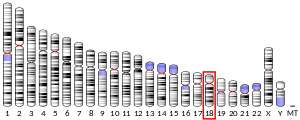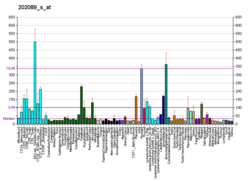SLC39A6
Zinc transporter ZIP6 is a protein that in humans is encoded by the SLC39A6 gene.[5][6][7]
Zinc is an essential cofactor for hundreds of enzymes. It is involved in protein, nucleic acid, carbohydrate, and lipid metabolism, as well as in the control of gene transcription, growth, development, and differentiation. SLC39A6 belongs to a subfamily of proteins that show structural characteristics of zinc transporters (Taylor and Nicholson, 2003).[supplied by OMIM][7]
See also
References
- 1 2 3 GRCh38: Ensembl release 89: ENSG00000141424 - Ensembl, May 2017
- 1 2 3 GRCm38: Ensembl release 89: ENSMUSG00000024270 - Ensembl, May 2017
- ↑ "Human PubMed Reference:".
- ↑ "Mouse PubMed Reference:".
- ↑ Taylor KM, Nicholson RI (Mar 2003). "The LZT proteins; the LIV-1 subfamily of zinc transporters". Biochim Biophys Acta. 1611 (1–2): 16–30. doi:10.1016/S0005-2736(03)00048-8. PMID 12659941.
- ↑ Taylor KM, Morgan HE, Johnson A, Hadley LJ, Nicholson RI (Sep 2003). "Structure-function analysis of LIV-1, the breast cancer-associated protein that belongs to a new subfamily of zinc transporters". Biochem J. 375 (Pt 1): 51–9. doi:10.1042/BJ20030478. PMC 1223660. PMID 12839489.
- 1 2 "Entrez Gene: SLC39A6 solute carrier family 39 (zinc transporter), member 6".
Further reading
- Manning DL, Daly RJ, Lord PG, et al. (1988). "Effects of oestrogen on the expression of a 4.4 kb mRNA in the ZR-75-1 human breast cancer cell line". Mol. Cell. Endocrinol. 59 (3): 205–12. doi:10.1016/0303-7207(88)90105-0. PMID 2903103.
- Dressman MA, Walz TM, Lavedan C, et al. (2002). "Genes that co-cluster with estrogen receptor alpha in microarray analysis of breast biopsies". Pharmacogenomics J. 1 (2): 135–41. PMID 11911440.
- Strausberg RL, Feingold EA, Grouse LH, et al. (2003). "Generation and initial analysis of more than 15,000 full-length human and mouse cDNA sequences". Proc. Natl. Acad. Sci. U.S.A. 99 (26): 16899–903. doi:10.1073/pnas.242603899. PMC 139241. PMID 12477932.
- Schaner ME, Ross DT, Ciaravino G, et al. (2004). "Gene expression patterns in ovarian carcinomas". Mol. Biol. Cell. 14 (11): 4376–86. doi:10.1091/mbc.E03-05-0279. PMC 266758. PMID 12960427.
- Zhang Z, Henzel WJ (2005). "Signal peptide prediction based on analysis of experimentally verified cleavage sites". Protein Sci. 13 (10): 2819–24. doi:10.1110/ps.04682504. PMC 2286551. PMID 15340161.
- Gerhard DS, Wagner L, Feingold EA, et al. (2004). "The status, quality, and expansion of the NIH full-length cDNA project: the Mammalian Gene Collection (MGC)". Genome Res. 14 (10B): 2121–7. doi:10.1101/gr.2596504. PMC 528928. PMID 15489334.
- Kasper G, Weiser AA, Rump A, et al. (2005). "Expression levels of the putative zinc transporter LIV-1 are associated with a better outcome of breast cancer patients". Int. J. Cancer. 117 (6): 961–73. doi:10.1002/ijc.21235. PMID 15986450.
- Zhao L, Chen W, Taylor KM, et al. (2007). "LIV-1 suppression inhibits HeLa cell invasion by targeting ERK1/2-Snail/Slug pathway". Biochem. Biophys. Res. Commun. 363 (1): 82–8. doi:10.1016/j.bbrc.2007.08.127. PMID 17825787.
This article is issued from
Wikipedia.
The text is licensed under Creative Commons - Attribution - Sharealike.
Additional terms may apply for the media files.





